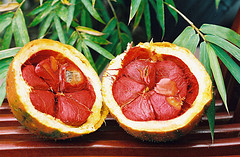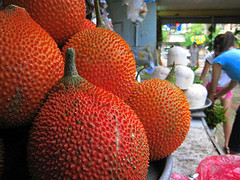|
|
||||||||||||||
|
Vietnamese gac fruit |
||||||||||||||
It less abundant than other
foods because it has a relatively short harvest season, which peaks in December
and January. Gac is typically served
at ceremonial or festive occasions in Vietnam, such as the Vietnamese New Year
and weddings. It is most commonly prepared as a dish called xoi gac, in which
the flesh and seeds of the fruit are cooked in a glutinous rice. More recently,
the fruit has begun to be marketed outside of Asia in the form of dietary supplements. Traditionally, gac fruit, seed
and its leaves have also been used as a traditional medicine in the regions in
which it grows. For example, the seed membranes are used to aid in the relief of
dry eyes, as well as to promote healthy vision. Similarly,
in China the seeds of gac, known in Mandarin Chinese, are employed for a variety
of internal and external purposes. Recently, attention is being to be attracted
to it in The West, because chemical analysis of the fruit suggests it has high
concentrations of several important phytonutrients, in addition to fibre and
vitamins. The fruit contains by far the
highest content of beta carotene (Vitamin A) of any known fruit or vegetable, up
to ten times more than carrots or
sweet potatoes. More importantly, the type of Research has confirmed that the
beta-carotene in the fruit is highly
bioavailable (easy absorbed into the blood stream).
This was demonstrated in a double-blind study with 185 children, half of
whom were given a dish containing 3.5 mg beta-carotene from gac, while others
were given an identical-looking dish containing 5 mg of artificial beta-carotene
powder. After 30 days, the former group eating natural beta-carotene had
significantly greater plasma (blood) levels of beta-carotene than the latter
with synthetic beta-carotene. The oil of gac also contains
high levels of vitamin E, essential long chain (healthy) fatty acids and
lycopene. Relative to mass, it contains up to 70 times the amount of lycopene
found in tomatoes. There has also
been recent research that suggests that gac contains a protein that may inhibit
the proliferation of cancer cells. How to eat Gac? There are a number of companies which are
commercially processing gac into supplements or juices. |
||||||||||||||
 Gac
fruit has been eaten in Vietnam for thousands of years for its nutritional and medicinal
properties.In the west it now becoming increasingly popular as a superfood in
view of its high
Gac
fruit has been eaten in Vietnam for thousands of years for its nutritional and medicinal
properties.In the west it now becoming increasingly popular as a superfood in
view of its high  If
the gac fruit is not a bright red is it not ripe enough to eat. It starts out
green, about the size of a cantaloupe and as it ripens goes through the yellow
and orange spectrum until it reaches a brilliant orange-red hue. They are at
their peak when they turn a brighter red just before spoiling. Warning! Do not
eat the sides, which is similar to the inner texture of a cantaloupe. This part
of the fruit, as well as the exterior rind are toxic and will make you feel ill
for a couple days if you attempt to eat it. The only parts that can be eaten are
the inner soft, oily pulp surrounding the seeds and the seeds themselves.
If
the gac fruit is not a bright red is it not ripe enough to eat. It starts out
green, about the size of a cantaloupe and as it ripens goes through the yellow
and orange spectrum until it reaches a brilliant orange-red hue. They are at
their peak when they turn a brighter red just before spoiling. Warning! Do not
eat the sides, which is similar to the inner texture of a cantaloupe. This part
of the fruit, as well as the exterior rind are toxic and will make you feel ill
for a couple days if you attempt to eat it. The only parts that can be eaten are
the inner soft, oily pulp surrounding the seeds and the seeds themselves.



